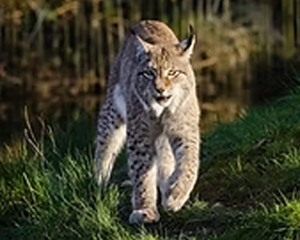Bobcat - Commonly Trapped Furbearer
UTILIZING OUR ABUNDANT MISSOURI WILDLIFE

Bobcat
Fast Facts
- Weight: ~20 pounds (adult male average)
- Teeth: 28
- Mating Season: February–March
- Gestation: 62–70 days
- Litter Size: ~3 kittens typical
- Female Territory: ~6 square miles
- Male Territory: Up to ~60 square miles
- Life Span: up to ~10 years
Bobcats are capable predators with reddish, grayish or brownish backs, short tails (5–6 inches), and a black spot near the tail end. They range widely from forests to prairie, are seldom seen, and are elusive—walking rather than bounding and relying heavily on keen hearing and eyesight. :contentReference[oaicite:3]{index=3}
Description
Males weigh about 20–22 lbs, females 18–19. In northern ranges some males reach 30 lbs or more. The bobcat has six inch tail, a face ruff, tufted ears with dark backs and white centers, and a coat with spots common in younger cats but often less in older individuals. Tracks differ by retractable claws. Bobcats have 28 teeth including 4 canines. :contentReference[oaicite:4]{index=4}
Reproduction
Breeding is generally February or March. Females use dens in rock cavities, hollow logs or other species’ burrows. Gestation lasts 62-70 days and usual litter size is 1-4, average around 3. Young are independent by the following winter. :contentReference[oaicite:5]{index=5}
Habits
Bobcats hunt primarily rabbits and rodents, sometimes deer when prey is scarce. Males have large overlapping territories; females smaller. Many female ranges cover ~6 sq miles while males may cover ~60. Most movement is slow patrol rather than high speed chase. :contentReference[oaicite:6]{index=6}
Range
Bobcats are found across much of the U.S. and southern Canada, ranging into Mexico. They inhabit varied habitats from forests to prairie to mountains. :contentReference[oaicite:7]{index=7}
General / Management Notes
Bobcats serve ecological roles controlling prey populations, but young are vulnerable to starvation and predation. Trappers and wildlife managers monitor bobcat populations closely. Diseases include rabies, feline distemper, mange and others. :contentReference[oaicite:8]{index=8}
Contact Missouri Trappers Association
Get in touch with the Missouri Trappers Association by filling out the contact form. We appreciate your support!
For questions regarding your membership, please call
Joslyn Search: (660)292-1911


